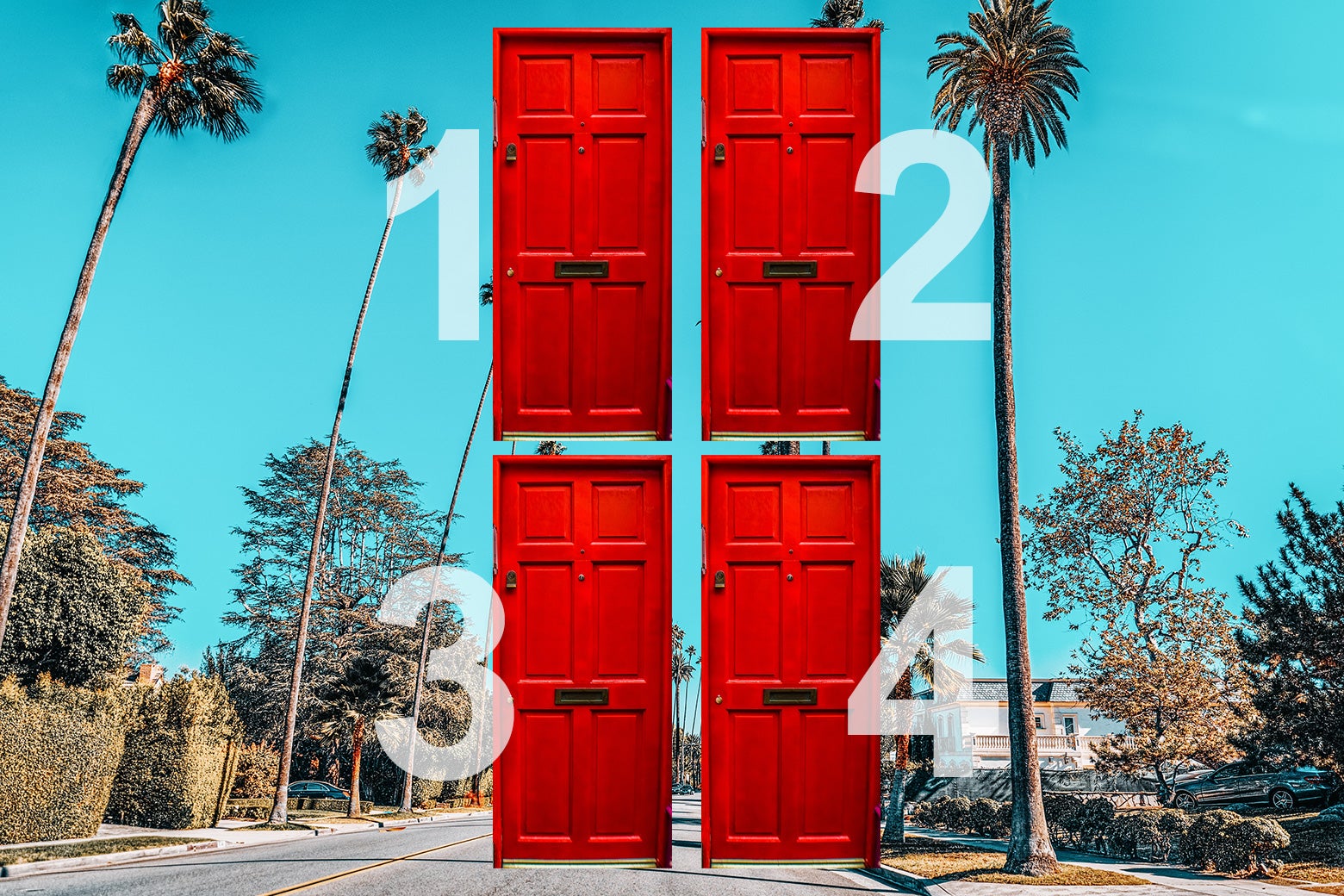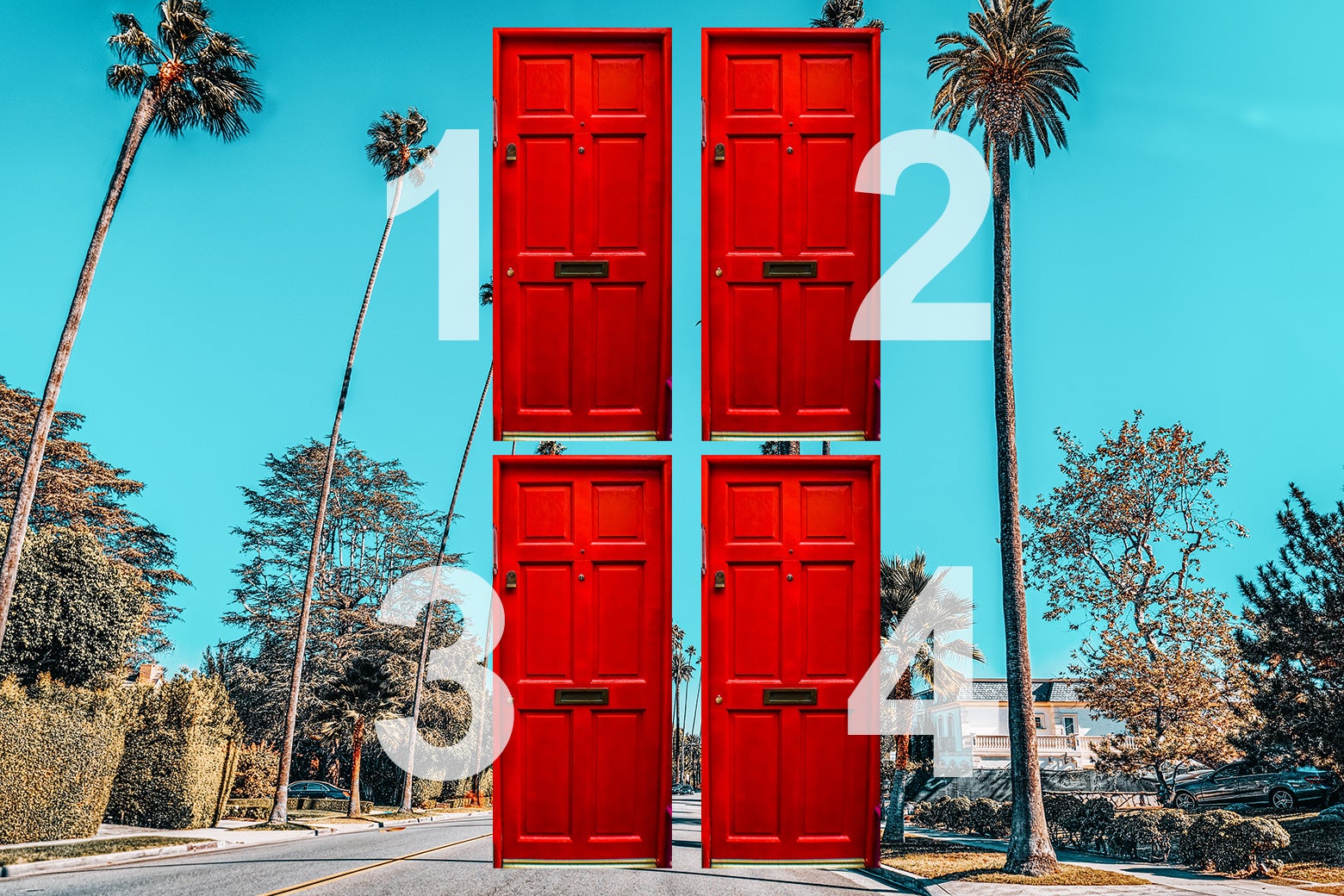City officials tried to rein in McMansions. They got these Frankenstein apartments instead.
By
Henry Grabar
Enter your email to receive alerts for this author.
Sign in or create an account to better manage your email preferences.

Sign up for the Slatest to get the most insightful analysis, criticism, and advice out there, delivered to your inbox daily.
City planning is hard. Consider Los Angeles, which wanted lower density in its crowded neighborhoods and also fewer McMansions. Like most places, the city has implemented more rigorous design and inspection standards for multifamily buildings than for one- or two-family homes.
What it got? An unholy specimen, a building creature that is sufficiently weird, necessary, and profitable to wriggle to life in the city’s stifling landscape of land-use regulations: the double duplex.
These megaduplexes, often doubled up two to a lot, do not resemble the two-family Cape Cods of yore. One three-story building on West 36th Street near the University of Southern California has 28 bedrooms and 28 bathrooms. Across the street, another has 45 bedrooms and 47 bathrooms. Technically duplexes (one building, two units), they are in reality sprawling dormitories, co-living facilities aimed at students, working adults, and formerly homeless populations.
The buildings are a visual record of a California housing crisis that has so far left few permanent monuments. They’re also an interesting example for cities in general of how an overlapping, contradictory web of regulations can lead to unintended consequences. You don’t always get what you want. But perhaps, Los Angeles, you might find that a double duplex is what you need.
In a recent paper published by George Mason University’s Mercatus Center, researchers Valerie Wilke, Eduardo Mendoza, and Muhammad Alameldin document the proliferation of this new housing type across L.A. They find that over 500 such developments had been permitted in the city through 2023, with more built since.
On Zillow, you can track down listings aimed at both prospective tenants and landlords. For investors, the pitch is high cap rates (the ratio of annual rent to purchase price) and an endless supply of tenants. Not mentioned are the rapid clip of turnover and wear and tear—most of the buildings are just a few years old.
For tenants, the principal lure is the price. One property offers beds for $599 a month—provided you’re willing to sleep four to a room in bunk beds. There’s a weekly cleaning service and an on-site manager, and you can rent month to month. At another property near USC, you can get your own bedroom and bathroom for $845. You have to share a kitchen with 14 other people, but it’s about half the price of getting a place of your own in the neighborhood.
Around USC, at least, many of the duplexians are students, whose dire housing needs have compelled California to contemplate radical proposals, like parking lots for students to sleep in their cars, or giant windowless megadorms.
Community members concerned about displacement of existing tenants for teardowns petitioned to stop the buildings, but pro-housing state preemption laws have superseded those efforts. Developers “are not seeing a house,” said Albizael Del Valle, capital projects director for the local council district. “They’re seeing 10 bedrooms, and every bedroom has two students and every student pays $1,200. The profit could be 600 percent.
“We provide more housing than other parts of the city,” he added, “but this is really a loophole that devs were able to find, and it’s quite dangerous. The value of the homes changed so quickly tenants can’t keep up, and people are incentivized to do evil things to get tenants out.”
Where students and young professionals see “co-living,” other tenants may see these structures as the second coming of the single-room-occupancy hotel. With its “Rooms for Rent” sign and weekly or monthly rates, the SRO once served a crucial role in the housing ecosystem of Los Angeles and other major cities, especially for younger residents, older adults, and those down on their luck.
For that last association, SROs were perceived as a cause of blight, and cities zoned new hotels out of existence and bulldozed existing buildings in the name of urban renewal—a displacement cataclysm lost to history because hotel tenants were not counted as residents on official ledgers. Cities like Los Angeles lost tens of thousands of SRO units in the 1970s and ’80s, and many contemporary observers note that their loss coincides with the beginning of the modern homelessness crisis. A new report from Pew details some of these connections.
Double duplexes house their fair share of low- or middle-income workers who find them on their own. (Advertisements are often posted in Spanish, a marketing approach probably not aimed at USC students.) But they have also become useful properties for the L.A. nonprofits that aim to get people who are living on the streets into supportive housing. The Los Angeles Homeless Services Authority takes out master leases, and nonprofit homeless service providers like PATH help place people there who have been living on the street.
“When I think about the landscape of L.A. housing availability, we need every option available,” Jennifer Hark Dietz, the CEO of PATH, told me. “What this type of housing does is it allows for folks to really come together and form a community. They’re using a community kitchen and community living space.” That’s been a recent focus of both the city and county of Los Angeles; they’ve tried to place homeless encampments into housing all at once—rather than divide up neighbors and damage support systems.
Needless to say, the dormlike apartments are also a lower-cost option than many studio or one-bedroom apartments. And because the units are leased by the government, the occupants of each bedroom do not have to undergo the background and credit checks that often make it hard for homeless people to secure housing.
The Mercatus report shows how the form sneaked through various zoning regulations. As duplexes, the buildings were permitted in neighborhoods of low-slung bungalows—but exempt from size limits that governed only single-family homes. They were also exempt from a bunch of requirements that Los Angeles has typically imposed on multifamily construction, such as the creation of open space and the provision of off-street parking spots. As a result, their approval has been streamlined at City Hall: According to Mendoza, it takes just 444 days for a double duplex to move from permit to occupancy, compared to 801 days for a typical multifamily project.
Relatedly, duplexes get to use the state’s simple single-family residential code instead of the more demanding guidelines that apply to apartment buildings. A step-up in the complexity of the code between two and three units has produced a lot of two-unit constructions built to lower safety standards, even though some of them have dozens of bedrooms inside. It’s not clear that’s a bad thing: Other cities have questioned whether single-family standards ought to be extended to small apartment buildings; Dallas recently decided that buildings with up to eight apartments could be built that way if they’re smaller than 7,500 square feet. (Some of LA’s double duplexes are so big they would not qualify under the Dallas law.)
This is also a reminder of how tricky it is to achieve that goal that every city seems to have: getting more family-size apartments to reverse the exodus of children from urban neighborhoods. The pro-housing advocate Oren Hadar recently spoke to a double duplex real estate agent who claims that the properties are increasingly being rented to multigenerational families. According to the Mercatus study, they’ve popped up in neighborhoods far from the region’s universities.
But families have trouble competing on price with single working adults (or college students drawing on the bank of Mom and Dad)—which is what has eaten up the big-city stock of family-size apartments in the first place. In New York City, for example, 1.9 million one- and two-person households were competing for 1.25 studios and one-bedroom apartments in 2014. That’s how you wind up with the famous adult cohabitations like that portrayed in Friends. Rather than expect families to live in student housing, we might instead hope that enough student housing takes the pressure off more traditional single-family homes, which (as the preferred outcome of our financial and legal systems) still make up the bulk of the housing stock—but are often subdivided between unrelated adults.
Sometimes, the double duplex is a density hack that undermines neighborhood efforts to banish apartments and their residents. But just as often, as the Mercatus study shows, the duplexes are built in neighborhoods where higher density of apartments is permitted. Developers choose to build these instead.
Get the best of news and politics
Sign up for Slate’s evening newsletter.
